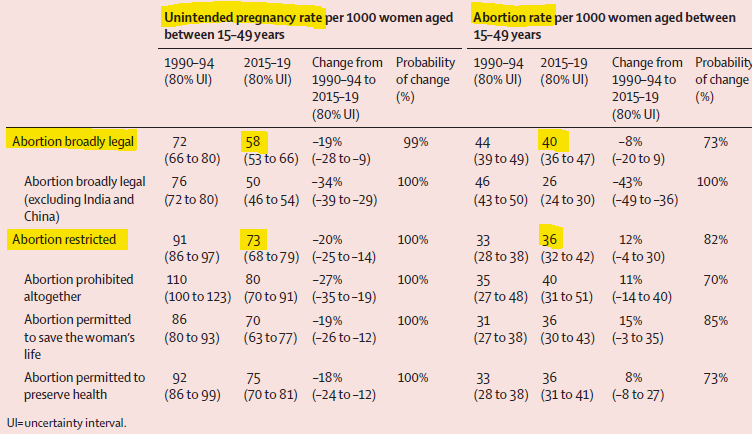Abortion laws decrease abortion rates internationally, but high unintended pregnancy rates can mask this effect
[Esta publicación está disponible en español aquí.]

[A version of this post is available on Twitter here.]
In September 2020, The Lancet published “Unintended pregnancy and abortion by income, region, and the legal status of abortion: estimates from a comprehensive model for 1990-2019.” The study discussed three factors:
- Unintended pregnancy (UIP) rates
- Abortion laws
- Abortion rates
Higher UIP drives up abortion rates. Stricter abortion laws drive down abortion rates. So we would expect countries with high UIP and permissive abortion laws to have the highest abortion rates while countries with low UIP and strict abortion laws should have the lowest abortion rates.
But often countries with high UIP have strict abortion laws and countries with low UIP have permissive abortion laws. As the paper explains:
We found that unintended pregnancy rates were generally higher in settings where abortion is restricted than in settings where it is broadly legal.
Bearak et al, The Lancet
This relationship between the two variables (UIP and abortion laws) complicates the analysis. The two factors have mitigating effects on one another and mask their individual effects on abortion rates.
This mitigating effect means countries with strict abortion laws and countries with lax abortion laws have similar abortion rates. People then incorrectly conclude the law doesn’t really affect abortion rates. The authors of the paper facilitate that erroneous conclusion with passages like this:
We found no evidence that abortion rates were lower in settings where abortion was restricted.
Bearak et al, The Lancet
Note the mitigating effect also means countries with high UIP (73 per 1000 women) and countries with low UIP (58 per 1000 women) have similar abortion rates (36 vs 40 per 1000 women), yet no one concludes unintended pregnancy rates don’t really affect abortion rates. See Table 2 from the study:

Also worth noting is the percent of unintended pregnancies aborted. According to the study, in countries where abortion is restricted about 50% of UIP are aborted; in countries where abortion is broadly legal, it’s about 70%. Both high percentages, to be sure, but a 20 point difference is huge. Abortion rights proponent and researcher Diana Greene Foster discussed this issue (based on similar data from a prior study) in her column “Stop Saying That Making Abortion Illegal Won’t Stop People From Having Them“:
The unintended pregnancy rate is significantly higher in countries where abortion is illegal – probably because contraceptives are also difficult to access. That only 48 percent of unintended pregnancies are aborted in countries where abortion is illegal compared to 69 percent where it is legal indicates that many women have carried unwanted pregnancies to term.
Diana Greene Foster, Rewire News Group
The 2020 Lancet study also found that global UIP decreased 18% from 1990 to 2019. If abortion rates were affected primarily by UIP, rather than by the law, we would expect global abortion rates to decrease along with the decrease in unintended pregnancy rates. Instead global abortion rates remained about the same. Why?
There are many factors in play, but abortion law is sure to be a major one. The Center for Reproductive Rights issued a report summarizing international abortion law from 1994-2014 which found:
During the past 20 years, more than 30 countries have liberalized their abortion laws, expanding the grounds under which women can legally access abortion services. Only a handful of countries have taken steps to legally restrict abortion or make it more difficult for women to procure abortions during this time.
Abortion Worldwide: 20 Year of Reform, Center for Reproductive Rights
So the global unintended pregnancy rate decreased, but global abortion laws on aggregate became more permissive. It shouldn’t be surprising, then, that the global abortion rate didn’t change much. Again, UIP and the law can have mitigating effects on each other.
Just as correlation isn’t always causation, lack of correlation isn’t always lack of causation. If we look at global abortion rates only in the context of abortion law, we don’t see a correlation. But if we control for unintended pregnancy rates, it appears strict abortion laws do decrease abortions.
If you appreciate our work and would like to help, one of the most effective ways to do so is to become a monthly donor. You can also give a one time donation here or volunteer with us here.




There’s another important cultural/sociological factor to note—in some societies, abortion is used by single women to delay childbirth; in others, it is primarily used my mothers to limit family size. This distinction is key to understanding how abortion impacts breast cancer rates in different nations. In general, where abortion is commonly used before the first live birth (i.e., the US), breast cancer rates are relatively high. In societies where married women with children are mostly choosing abortion, the protective effect of a first live birth shows up in national breast cancer rates.
Interesting, I have not heard that suggestion before. Do you know of any studies covering it?
The first report of what seems to have been the same ongoing project appeared in Lancet in 2008. The project was headed the first few times by Gilda Sedgh of the Guttmacher Institute. Now she seems to be out; I don’t know if any of the original people are still in.
The reports seem to have gotten more honest over the years. The first ones invited being interpreted to mean “more restrictive abortion laws somehow (?) CAUSE higher abortion rates,
‘ and pro-choicers couldn’t resist interpreting them that way. A notable example was one Libby Anne, who wrote the very influential “How I Lost Faith in the Pro-Life Movement.”
I do vaguely remember that Libby Anne piece, although I’d forgotten she referenced this mistaken pro-choice argument. It’s such a pervasive argument.